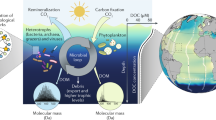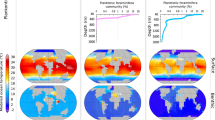Abstract
DIFFERENT views are still held as to where life in the world had its origin, but no one questions that it began in close connexion with water. That it began in the sea, where the necessary elements were present in appropriate concentrations and in an ionised state, is an idea which appeals to many with increasing force the more closely it is examined. This view has been developed recently by Church2 in his memoir on "The Building of an Autotrophic Flagellate,"in which he boldly attempts to trace the progression from the inorganic elements present in sea-water to the unicellular flagellate in the plankton phase, floating freely in the water. The autotrophic flagellate, manu-r facturing its own food, he regards as the starting-point from which all other organisms, both plants and animals, have sprung. To understand the first step in this progression, the passage from the dead inorganic to the living organic remains, is as it has always been, Qne of the great goals of science, not of biological science alone, but of all science. Recent research has, I thinkj thrown much light on the fundamental problems im volved. In a paper published last year, Baly, Heilbron, and Barker,3 extending and correcting previous work by Benjamin Moore and Webster,4 have shown that light of very short wave-length (λ = 200 µµ), obtained from a mercury-vapour lamp, acting upon water and carbon dioxide alone, is capable of producing formaldehyde, with liberation of free oxygen. Light of a some^ what longer wave-length (λ = 290 µµ) causes the mole* cules of formaldehyde to unite or polymerise to form simple sugars, six molecules of formaldehyde, for example, uniting to form hexose. The arresting fact brought out in these researches is that the reactions take place, under the influence of light of appropriate wave-lengths, without the help of any catalyst, either organic or inorganic. Where a source of light is used which furnishes rays of many wave-lengths, the simple reaction of the formation of formaldehyde is masked by the immediate condensation of the formaldehyde to sugar, but this can be prevented by adding to the solution a substance which absorbs the longer waye-lengths, so that only the short ones which produce formaldehyde are able to act.
This is a preview of subscription content, access via your institution
Access options
Subscribe to this journal
Receive 51 print issues and online access
$199.00 per year
only $3.90 per issue
Buy this article
- Purchase on Springer Link
- Instant access to full article PDF
Prices may be subject to local taxes which are calculated during checkout
Similar content being viewed by others
References
"Biological Memoirs," 1. Oxford, 1919.
Journ. Chem. Soc., London, vols. 119 and 120, 1921, p. 1025. NATURE, vol. 109, 1922, p. 344.
Proc. Roy. Soc. B., vol. 87, p. 163 (1913), p. 556 (1914); vol. 90, p. 168. (1918).
Proc. Roy. Soc. B., vol. 90, p. 158 (1918); vol. 92, p. 51 (1921).
Baly, Heilbron and Hudson, Journ. Chem. Soc., London, vols. 121 and 122, 1922, p. 1078.
"Treatise on Zoology," Part 1., Introduction. London, 1909.
Carl Snyder, "Life without Oxygen," Science Progress, vol. vi., 1912, p. 107.
Kofoid and Swezy, "The Free-living Unarmoured Dinoflagellata." Mem. Univ. California, 1921.
Osborn, " Origin and Evolution of Life," 1918, p. 153.
Chamberlin, quoted in Lull, " Organic Evolution," New York, 1917, p. 462.
Rights and permissions
About this article
Cite this article
ALLEN, E. The Progression of Life in the Sea. Nature 110, 448–453 (1922). https://doi.org/10.1038/110448a0
Issue Date:
DOI: https://doi.org/10.1038/110448a0
Comments
By submitting a comment you agree to abide by our Terms and Community Guidelines. If you find something abusive or that does not comply with our terms or guidelines please flag it as inappropriate.



